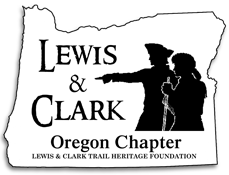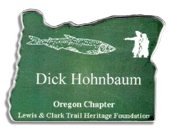September 2019

Official Newsletter of the Oregon Chapter of the Lewis & Clark Trail Heritage Foundation
President's Corner

As the Corps of Discovery ascended the Missouri River on June 2, 1805, the river split into two branches. The left branch [Missouri] came from the NW, was 372 yards wide, clear, shallow, and swift, and had a rocky bottom. The right branch [Marias] came from the N, was 200 yards wide, muddy, deeper, and slower-moving, and had a muddy bottom. Correctly identifying the right branch as the true Missouri would be critical to the Expedition’s success—choosing the wrong branch would cost it valuable time needed to get over the Rocky Mountains before winter set in.
The expedition camped there for 11 nights while the captains deliberated carefully. After evaluating all the available information, Lewis told the men the decision: to ascend the left branch of the river.
Lewis wrote: The entire party [including their best waterman, Cruzatte] thought the right branch was the true Missouri. They said very cheerfully that they were ready to follow us any wher we thought proper to direct but that they still thought the other river was the [Missouri] river and that they were afraid that the South fork would soon termineate in the mountains and leave us at a great distance from the Columbia.
So why did the Captains go against the opinion of the entire party?
I believe it was principally due to very keen geological observations of the stream bed that, with secondary supportive information, convinced the captains that the left fork was the true Missouri.
The rest of the party’s opinion was largely based on the nature of the right fork. It was muddy and turbulent like the river downstream that they had been ascending since they left St. Louis. However, the Captains considered the evidence differently. Clark observed that left branch is perfectly transparent runds very rapid but with a smoth unriffled surface it’s bottom composed of round and flat smooth stones like most rivers issuing from mountainous country.
Evaluating the rocks in the rivers carried downstream on each branch is a simple geologic concept, but it was actually a quite brilliant observation.
This is a lesson for all of us. When making important decisions we need be of independent mind, observe carefully, listen to others, evaluate all the information, and then proceed on with confidence.
Glen Kirkpatrick
glen9774@mail.com
Touring the Oregon Vault — May 2019
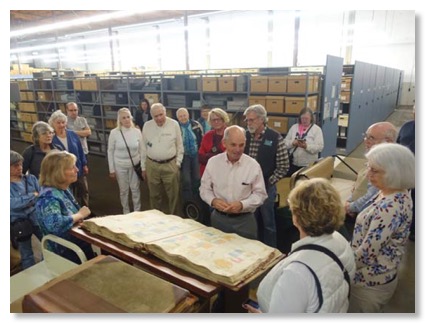
collections of the Oregon Historical Society, hosted the Oregon
Chapter in May. The fascinating tour, led by OHS executive director
Kerry Tymchuk, began with an examination of Sanborn Maps of
Portland (above). Chapter president Glen Kirkpatrick failed to find
his “white whale”—the very large whalebone inscribed by Meriwether
Lewis—but vowed to continue his search (see below).
Housed in a nondescript warehouse at an unpublicized location in Gresham, the 100,000-square-foot storage facility holds the bulk of the OHS collections.
The tour included explanations of the Society’s accession and deaccessioning processes as well as tips-of-the-iceberg views of manuscript, vehicle, costume, native artifact, and film collections.

Larry McClure Receives Top Foundation Award
The national Lewis & Clark Trail Heritage Foundation owes Larry McClure a huge debt of gratitude. In recognition, it will present Larry with its Distinguished Service Award, the highest honor that it bestows, at its annual meeting this month in St. Louis. Larry has organized two national meetings (2005 & 2018); helped reconstitute the foundation board as secretary in 2011 after all the other officers and the executive director resigned; and served in many other capacities, including 20 years on our board (and President 2007–2010).Chapter Activities
Explore More!

whale bones hoping to find the lost artifact associated with the
Lewis & Clark Expedition which he’d seen on display in 1976.
Watch your mail and e-mail, and especially the chapter website for more information and details.
Oregon Chapter's Name Badges
Send $10 and your name (as you want it to appear), to Ellie McClure, 17760 S.W. Cheyenne Way, Tualatin, OR 97062 (Ellie.McClure@or-lcthf.org). Make checks payable to OR-LCTHF. (click the picture above to see a larger image.)
2019 Chapter Events
See the Events page for more details if available!
- Oct. 12, 1:00 PM Melissa Darby speaks on Sir Francis Drake’s 1579 landing on the Oregon Coast: West Linn Public Library. Her new book is Thunder Go North: The Hunt for Sir Francis Drake’s Fair and Good Bay
- Dec. 7, 4:00 PM Holiday dinner at Fort Clatsop. Bill Gavin & Rachel Stokeld speak on “The Archaeology of Middle Village”.
Prospective 2020 Events:
- Charbonneau interpreter
- Old John & the Spider
- Portland L&C campsites and commemorations
- Confluence sites
- Let us know if you want to help.
Officers:
President | Glen Kirkpatrick '19 |
| Vice President | Lyn Trainer ’20 |
| Secretary | Mark Johnson '19 |
| Treasurer | Ellie McClure ’20 |
| Directors | Alec Burpee ‘21 David Ellingson ‘20 Thelma Haggenmiller ‘19 Mary Johnson ‘21 Ted Kaye ‘19 Zachariah Selley ’20 Roger Wendlick ‘21 |
| Ex Officio | Jon Burpee Hannah Crummé Larry McClure |
Please contact Glen Kirkpatrick with interest in Chapter service.
L&C in OHS’s Experience Oregon
The Oregon Historical Society’s new permanent Experience Oregon exhibit prominently features the Lewis & Clark story. A significant display interprets the Expedition’s importance to Oregon history through three Expedition artifacts and extensive images and other items.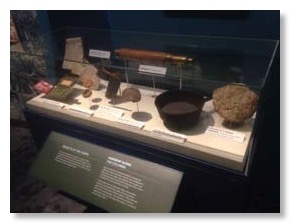 | 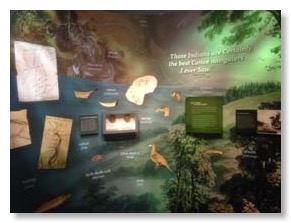 |
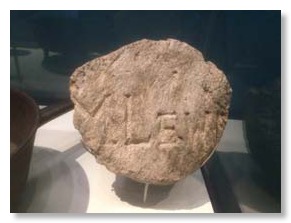 | Top Right: Interpretive wall. Bottom Left: Whalebone Fragment. |
L&C Sites near Prescott Beach, Oregon — August 2019

Roger Wendlick describes the Expedition’s local experience.
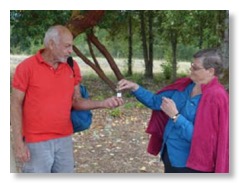
presents a tribal-made miniature
basket as a thank-you to the
speaker, Roger Wendlick
In August, 15 chapter members gathered at Prescott Beach Park, along the Columbia River in Columbia County, near two Lewis & Clark Expedition campsites.
After a board meeting and a potluck picnic, they heard Roger Wendlick describe the Corps’ local history using William Clark’s map. Afterwards they trooped downstream to the November 5, 1805 campsite, across the railroad tracks in Laurel Beach Park (closed), then journeyed upstream to the vicinity of the March 27, 1806 campsite. Both have been altered by dredge spoils and the railroad, but the Columbia River itself looks much as the Expedition saw it.

Chapter president Glen Kirkpatrick points out the Corps’ campsite
of November 5, 1805, downstream from Prescott Beach Park.
